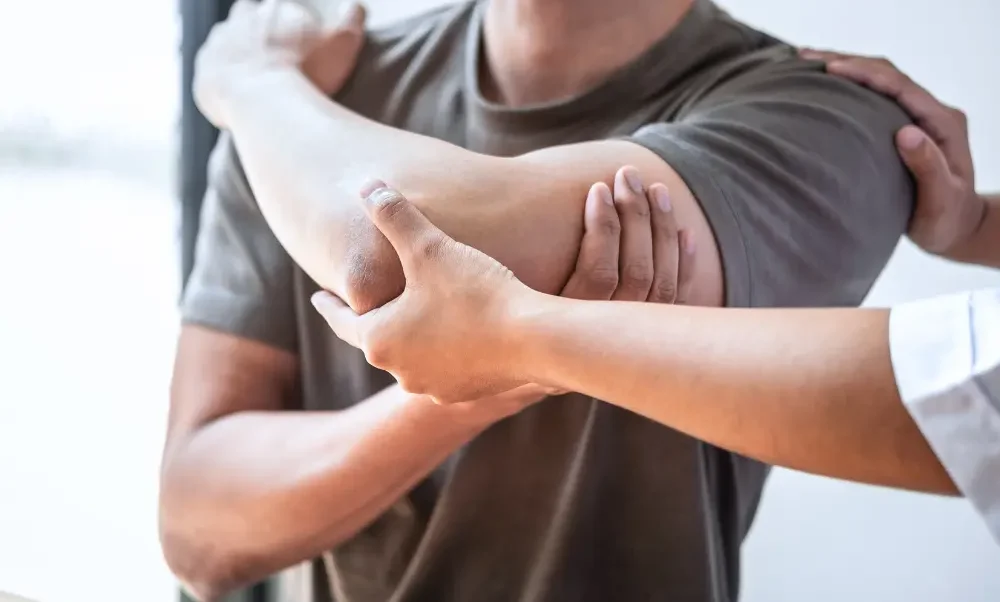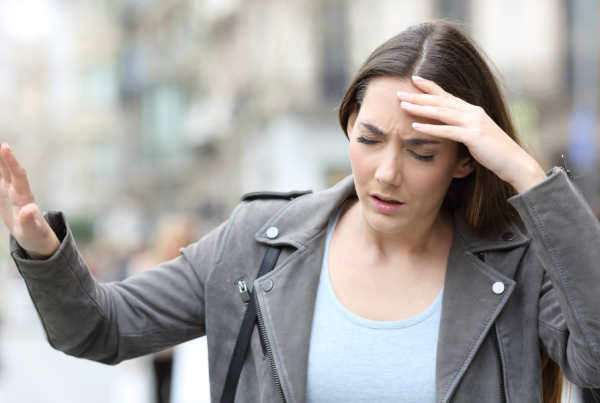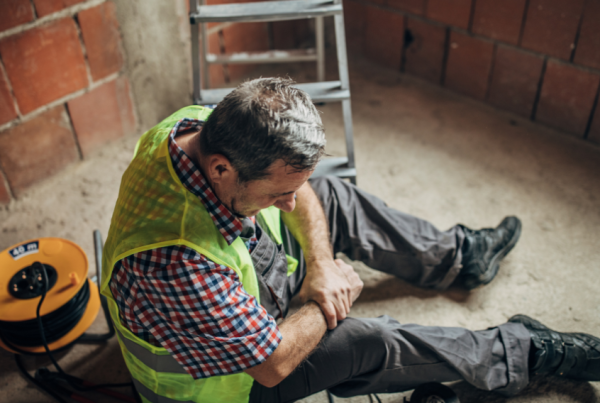Elbow Pain
Move Better. Live Fuller. Your Wellness Journey Starts Here.
Schedule a FREE Discovery Call!
About Elbow Pain
The elbow is an important joint used daily by many people for their jobs, sports, and normal everyday activities. It consists of several joints that allow for flexion (bringing the hand towards the face), extension (bringing the hand away from the face), and turning the hand palm up and down (pronation and supination, respectively).
In some cases, individuals may begin to experience elbow pain, which can often be attributed to overuse or injury. This is more common with people who perform repetitive motions with their arms. While the elbow is less likely to experience damage as other locations (such as the wrist), it is not entirely uncommon.
Pain felt in the elbow area can be caused by a variety of conditions, and can also involve the surrounding muscles, tendons, nerves, or ligaments. Some common symptoms of elbow conditions include:

- Pain: Elbow pain can range from mild discomfort to severe pain. Depending on the cause, it may be felt constantly, come and go, or only after specific movements. The pain may feel sharp, achy, or tingly.
- Swelling: Typically, with elbow injuries, individuals may experience swelling, inflammation, tenderness, and warmth.
- Stiffness: Alongside pain, stiffness coupled with a decreased range of motion may occur. The joint may feel tighter, especially after long periods of inactivity.
- Numbness or tingling: If the pain is caused by nerve compression or damage, individuals may experience a numbness or tingling sensation.
- Weakness: Performing normal tasks and simple motions may be more difficult, often resulting from a weakness in the muscles surrounding the elbow.
- Locking or catching: In some cases, the elbow may feel as though it is locking or catching during movements. This can feel uncomfortable or even painful.
What Causes Elbow Pain?
As mentioned previously, overuse and injury are the main causes of elbow pain. However, this can occur in a multitude of ways, as your elbow is connected to different parts of your arm and helps assist with a plethora of different motions. So, let’s look at some common elbow-related conditions:
Lateral Epicondylitis
Also called Tennis Elbow, this condition is often caused by repetitive motions that stress or even damage the muscles and tendons on the outside of the elbow. Depending on the motion, different muscles activate around the elbow; the repetitive motion that can create lateral epicondylitis is extending your wrist (bringing the back of your hand towards the back of your forearm).
Despite the name, tennis players aren’t necessarily the main psychographic group affected by this condition. It can affect any person who performs repetitive wrist extension motions.
Medial Epicondylitis
This condition originates from stress and possibly damage to muscles and tendons that attach to the inside area of the elbow. It is commonly known as Golfer’s Elbow. Like the above condition, this problem arises from repetitive motions; in this case, flexing your wrist (bringing your palm toward your forearm).
Similarly to Tennis Elbow, this condition can affect people other than golfers if they perform this wrist flexion motion very often.
Biceps Tendonitis
This condition is an inflammation of the tendon that connects your bicep to both your elbow and shoulder. Overuse and repetitive motions that stress this area can lead to pain and irritation. Motions that may cause this include overhead motions, lifting, or pulling.
Throwing Injuries
Those who engage in sports that involve repetitive throwing motions (such as baseball pitchers) may experience elbow pain. A common experience with this repetitive motion is damage to the ulnar collateral ligament. This sports injury causes pain on the inside of the elbow, making it difficult to continue throwing motions.
Elbow Sprains and Strains
Overuse or injury of the muscles, ligaments, or tendons of the elbow can result in elbow pain.
Olecranon Bursitis
This condition is an inflammation of the olecranon bursa, a fluid filled sac located on the bony tip of the elbow. It serves as a cushion that allows other tissues such as skin to glide over the bone. Irritation or injury to this bursa can lead to swelling and pain in the area.
Cubital Tunnel Syndrome
This condition is caused by compression of the ulnar nerve at the elbow. The ulnar nerve is one of the main three nerves found in your arm. Compression of this nerve can lead to numbness, tingling, and pain. This condition is also called ulnar nerve entrapment.
Nerve Entrapment
Refers to the entrapment or compression of a nerve between two other structures such as ligaments or bones; it is often caused by repetitive motions. As mentioned above, this often occurs to the ulnar nerve, but can affect other nerves in the arm, too.
Osteoarthritis
This condition is a form of degenerative joint disease and is the most common form of arthritis. It is caused by overuse and general wear-and-tear of the elbow area. It causes pain, stiffness, and reduced range of motion.
Physical Therapy for Elbow Pain
Our physical therapists at Hive Therapy and Wellness can treat elbow pain and are very experienced in working with a variety of different athletes. If you are an athlete or individual experiencing elbow pain, we are here to help!
A diagnosis usually begins with a look at your medical history and any past injuries to the elbow or related areas. Your physical therapist will request information about your symptoms. This includes the duration and intensity of your pain, as well as what motions may exacerbate it. Your physical therapist may perform a physical exam of your elbow, arm, and shoulder to check for abnormalities, range of motion, muscle strength, function, and movement patterns. They may test your ability to perform certain movements within your range of comfort.
Based on your diagnosis and possible causes of pain, your physical therapist will create an individualized plan of care to treat the issue and manage your pain. Your specific treatment plan will work to improve the function, range of motion, and strength of your elbow. The treatments may include exercises, pain relief strategies, manual therapy, and much more. Your physical therapist can educate you on proper posture or form during movements, which can prevent future injury or complications. At Hive Therapy and Wellness, the following treatments are often utilized to treat elbow pain:
- Dry needling
- Cupping
- Manual therapy
- Spinal manipulation
- Electrical muscle stimulation
- Tissue scraping
- Exercise prescription
- Behavioral modifications
- Therapeutic modalities
- Neuromuscular re-education
- Biofeedback
- Therapeutic activity
The elbow is an important joint used daily by many people for their jobs, sports, and normal everyday activities. It consists of several joints that allow for flexion (bringing the hand towards the face), extension (bringing the hand away from the face), and turning the hand palm up and down (pronation and supination, respectively).
In some cases, individuals may begin to experience elbow pain, which can often be attributed to overuse or injury. This is more common with people who perform repetitive motions with their arms.
While the elbow is less likely to experience damage as other locations (such as the wrist), it is not entirely uncommon. Pain felt in the elbow area can be caused by a variety of conditions, and can also involve the surrounding muscles, tendons, nerves, or ligaments. Some common symptoms of elbow conditions include:
- Pain: Elbow pain can range from mild discomfort to severe pain. Depending on the cause, it may be felt constantly, come and go, or only after specific movements. The pain may feel sharp, achy, or tingly.
- Swelling: Typically, with elbow injuries, individuals may experience swelling, inflammation, tenderness, and warmth.
- Stiffness: Alongside pain, stiffness coupled with a decreased range of motion may occur. The joint may feel tighter, especially after long periods of inactivity.
- Numbness or tingling: If the pain is caused by nerve compression or damage, individuals may experience a numbness or tingling sensation.
- Weakness: Performing normal tasks and simple motions may be more difficult, often resulting from a weakness in the muscles surrounding the elbow.
- Locking or catching: In some cases, the elbow may feel as though it is locking or catching during movements. This can feel uncomfortable or even painful.
As mentioned previously, overuse and injury are the main causes of elbow pain. However, this can occur in a multitude of ways, as your elbow is connected to different parts of your arm and helps assist with a plethora of different motions.
So, let’s look at some common elbow-related conditions:
Lateral Epicondylitis
Also called Tennis Elbow, this condition is often caused by repetitive motions that stress or even damage the muscles and tendons on the outside of the elbow.
Depending on the motion, different muscles activate around the elbow; the repetitive motion that can create lateral epicondylitis is extending your wrist (bringing the back of your hand towards the back of your forearm).
Despite the name, tennis players aren’t necessarily the main psychographic group affected by this condition. It can affect any person who performs repetitive wrist extension motions.
Medial Epicondylitis
This condition originates from stress and possibly damage to muscles and tendons that attach to the inside area of the elbow. It is commonly known as Golfer’s Elbow. Like the above condition, this problem arises from repetitive motions; in this case, flexing your wrist (bringing your palm toward your forearm).
Similarly to Tennis Elbow, this condition can affect people other than golfers if they perform this wrist flexion motion very often.
Biceps Tendonitis
This condition is an inflammation of the tendon that connects your bicep to both your elbow and shoulder. Overuse and repetitive motions that stress this area can lead to pain and irritation. Motions that may cause this include overhead motions, lifting, or pulling.
Throwing Injuries
Those who engage in sports that involve repetitive throwing motions (such as baseball pitchers) may experience elbow pain. A common experience with this repetitive motion is damage to the ulnar collateral ligament. This sports injury causes pain on the inside of the elbow, making it difficult to continue throwing motions.
Elbow Sprains and Strains
Overuse or injury of the muscles, ligaments, or tendons of the elbow can result in elbow pain.
Olecranon Bursitis
This condition is an inflammation of the olecranon bursa, a fluid filled sac located on the bony tip of the elbow. It serves as a cushion that allows other tissues such as skin to glide over the bone. Irritation or injury to this bursa can lead to swelling and pain in the area.
Cubital Tunnel Syndrome
This condition is caused by compression of the ulnar nerve at the elbow. The ulnar nerve is one of the main three nerves found in your arm. Compression of this nerve can lead to numbness, tingling, and pain. This condition is also called ulnar nerve entrapment.
Nerve Entrapment
Refers to the entrapment or compression of a nerve between two other structures such as ligaments or bones; it is often caused by repetitive motions. As mentioned above, this often occurs to the ulnar nerve, but can affect other nerves in the arm, too.
Osteoarthritis
This condition is a form of degenerative joint disease and is the most common form of arthritis. It is caused by overuse and general wear-and-tear of the elbow area. It causes pain, stiffness, and reduced range of motion.
Our physical therapists at Hive Therapy and Wellness can treat elbow pain and are very experienced in working with a variety of different athletes. If you are an athlete or individual experiencing elbow pain, we are here to help!
A diagnosis usually begins with a look at your medical history and any past injuries to the elbow or related areas. Your physical therapist will request information about your symptoms. This includes the duration and intensity of your pain, as well as what motions may exacerbate it.
Your physical therapist may perform a physical exam of your elbow, arm, and shoulder to check for abnormalities, range of motion, muscle strength, function, and movement patterns. They may test your ability to perform certain movements within your range of comfort.
Based on your diagnosis and possible causes of pain, your physical therapist will create an individualized plan of care to treat the issue and manage your pain.
Your specific treatment plan will work to improve the function, range of motion, and strength of your elbow. The treatments may include exercises, pain relief strategies, manual therapy, and much more.
Your physical therapist can educate you on proper posture or form during movements, which can prevent future injury or complications. At Hive Therapy and Wellness, the following treatments are often utilized to treat elbow pain:
- Dry needling
- Cupping
- Manual therapy
- Spinal manipulation
- Electrical muscle stimulation
- Tissue scraping
- Exercise prescription
- Behavioral modifications
- Therapeutic modalities
- Neuromuscular re-education
- Biofeedback
- Therapeutic activity
You can learn more about these treatments on our Treatments Page.





